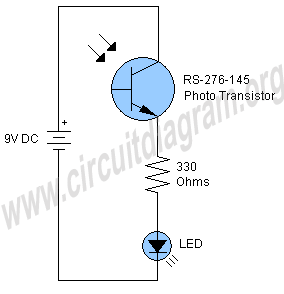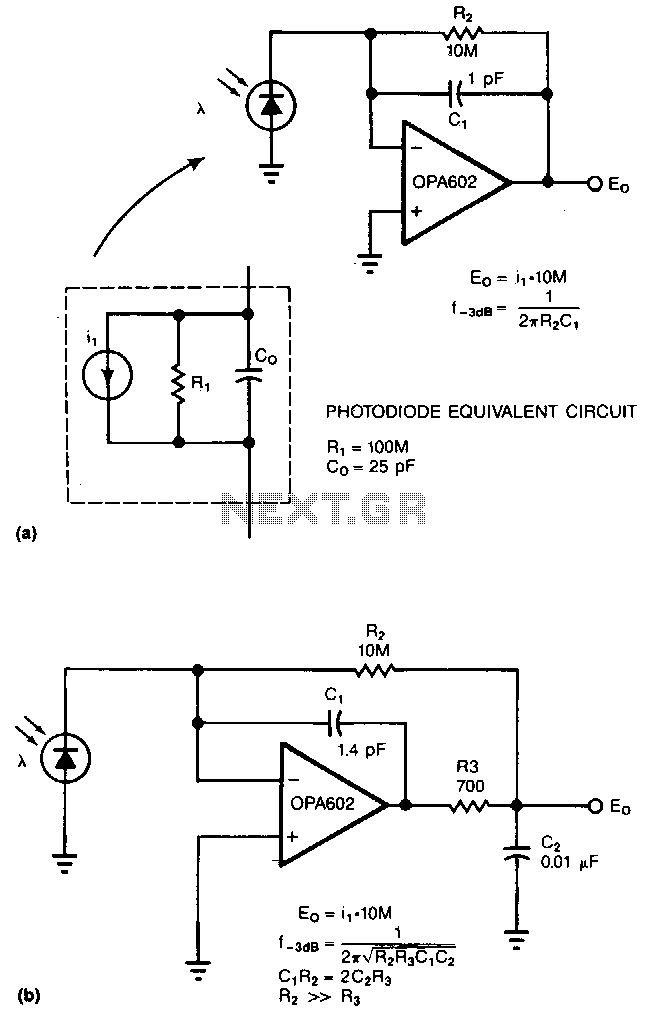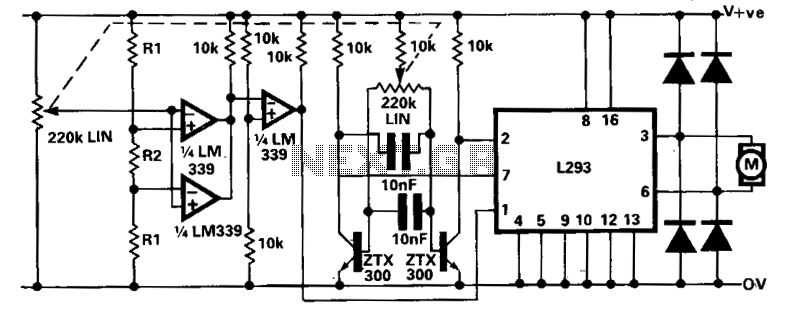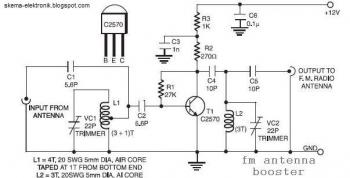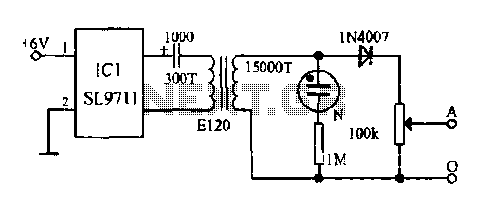
laser diode driver circuit

This circuit design for a laser diode driver can be implemented using a voltage-controlled current source. This simple linear laser diode driver provides a cleaner drive current compared to switched (PWM) drivers. The circuit is based on the OPA350 IC. A Howland current pump with a current booster serves as the foundation for this laser diode driver. Q1 functions as the current booster at the output of the R-R CMOS OPA350 op-amp (U2). The voltage drop across a shunt resistor (RSHUNT) in series with the laser diode is measured differentially to sense the current. An analog voltage from a potentiometer or from a microprocessor-controlled DAC can be fed to VIN to control the laser diode current. With the specified component values, the scale factor is 1V input equals 1A output.
The laser diode driver circuit utilizes a voltage-controlled current source architecture to deliver precise current to the laser diode, ensuring optimal performance and longevity of the diode. The OPA350 operational amplifier, known for its low offset voltage and high precision, is employed in a rail-to-rail configuration to maximize output swing and drive capability.
The Howland current pump configuration is particularly advantageous in this application due to its ability to provide stable current output regardless of load variations. The inclusion of Q1 as a current booster enhances the output drive capability, allowing for higher currents to be delivered to the laser diode while maintaining linearity and minimizing distortion.
The shunt resistor (RSHUNT) is strategically placed in series with the laser diode to enable accurate current sensing. By measuring the voltage drop across this resistor, the circuit can determine the actual current flowing through the diode, facilitating feedback control. This feedback loop is crucial for maintaining the desired current level, especially in applications where the diode characteristics may change with temperature or aging.
The control input (VIN) can be adjusted using an analog voltage from a potentiometer or a digital-to-analog converter (DAC) controlled by a microprocessor. This flexibility allows for easy integration into automated systems or manual adjustments, providing versatility in various operational scenarios.
The design achieves a scale factor of 1V input to 1A output, making it straightforward to calculate the required input voltage for a specific desired output current. This linear relationship simplifies the design process for applications requiring precise control over laser diode operation, such as in optical communication systems, laser cutting, or medical devices.
Overall, this laser diode driver circuit is characterized by its simplicity, precision, and reliability, making it an excellent choice for applications demanding high-quality laser performance.This is circuit design for a laser diode driver can be implemented using voltage-controlled current source. This simple linear laser diode driver gives cleaner drive current than a switched (PWM) drivers. This circuit is based on OPA350 IC. This is the figure of the circuit. A Howland current pump with a current booster is used as the basic of thi s laser diode driver. Q1 is used as the current booster on the output of a R-R CMOS OPA350 op amp (U2). Voltage drop across a shunt resistor (RSHUNT) in series with the laser diode is measured differentially to sense the current. An analog voltage from a potentiometer of from a microprocessor controlled DAC can be fed to VIN to control the laser diode current.
Using the component values as shown, the scale factor is 1V input equals 1A output. 🔗 External reference
The laser diode driver circuit utilizes a voltage-controlled current source architecture to deliver precise current to the laser diode, ensuring optimal performance and longevity of the diode. The OPA350 operational amplifier, known for its low offset voltage and high precision, is employed in a rail-to-rail configuration to maximize output swing and drive capability.
The Howland current pump configuration is particularly advantageous in this application due to its ability to provide stable current output regardless of load variations. The inclusion of Q1 as a current booster enhances the output drive capability, allowing for higher currents to be delivered to the laser diode while maintaining linearity and minimizing distortion.
The shunt resistor (RSHUNT) is strategically placed in series with the laser diode to enable accurate current sensing. By measuring the voltage drop across this resistor, the circuit can determine the actual current flowing through the diode, facilitating feedback control. This feedback loop is crucial for maintaining the desired current level, especially in applications where the diode characteristics may change with temperature or aging.
The control input (VIN) can be adjusted using an analog voltage from a potentiometer or a digital-to-analog converter (DAC) controlled by a microprocessor. This flexibility allows for easy integration into automated systems or manual adjustments, providing versatility in various operational scenarios.
The design achieves a scale factor of 1V input to 1A output, making it straightforward to calculate the required input voltage for a specific desired output current. This linear relationship simplifies the design process for applications requiring precise control over laser diode operation, such as in optical communication systems, laser cutting, or medical devices.
Overall, this laser diode driver circuit is characterized by its simplicity, precision, and reliability, making it an excellent choice for applications demanding high-quality laser performance.This is circuit design for a laser diode driver can be implemented using voltage-controlled current source. This simple linear laser diode driver gives cleaner drive current than a switched (PWM) drivers. This circuit is based on OPA350 IC. This is the figure of the circuit. A Howland current pump with a current booster is used as the basic of thi s laser diode driver. Q1 is used as the current booster on the output of a R-R CMOS OPA350 op amp (U2). Voltage drop across a shunt resistor (RSHUNT) in series with the laser diode is measured differentially to sense the current. An analog voltage from a potentiometer of from a microprocessor controlled DAC can be fed to VIN to control the laser diode current.
Using the component values as shown, the scale factor is 1V input equals 1A output. 🔗 External reference
